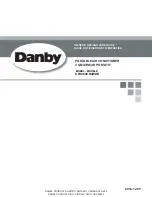
Maintenance
RT-SVX34F-EN
101
Refrigeration System
Refrigerant Evacuation and Charging
Note:
Do not release refrigerant to the atmosphere! If
adding or removing refrigerant is required, the
service technician must comply with all federal,
state, and local laws.
•
To prevent cross contamination of refrigerants and
oils, use only dedicated R-410A service equipment.
•
Disconnect unit power before evacuation and do not
apply voltage to compressor while under vacuum.
Failure to follow these instructions will result in
compressor failure.
•
Due to the presence of POE oil, minimize system open
time. Do not exceed 1 hour.
•
When recharging R-410A refrigerant, it should be
charged in the liquid state.
•
It is recommended that the compressor should be off
when the initial refrigerant recharge is performed.
•
It is recommended that the initial refrigerant be
charged into the liquid line prior to starting the
compressor. This will minimize the potential damage
to the compressor due to refrigerant in the compressor
at startup.
Important:
Do not charge liquid refrigerant into the
suction line with the compressor off. This
increases both the probability that the
compressor will start with refrigerant in the
compressor oil sump and the potential for
compressor damage.
•
If suction line charging is needed to complete the
charging process, only do so with the compressor
operating.
•
Allow the crankcase heater to operate a minimum of 8
hours before starting the unit.
Charge Storage
Due to the reduced capacity of the microchannel
condenser coil compared to the round tube plate fin
evaporator coil, pumping refrigerant into the condenser
coil to service the refrigerant system is no longer an
option.
Compressor Oil
If a motor burn out is suspected, use an acid test kit to
check the condition of the oil. Test results will indicate an
acid level has exceeded the limit if a burn out occurred. Oil
Figure 62.
Fall restraint
WARNING
R-410A Refrigerant under Higher Pressure
than R-22!
The units described in this manual use R-410A
refrigerant which operates at higher pressures than R-22
refrigerant. Use ONLY R-410A rated service equipment
or components with these units. For specific handling
concerns with R-410A, please contact your local Trane
representative.
Failure to use R-410A rated service equipment or
components could result in equipment exploding under
R-410A high pressures which could result in death,
serious injury, or equipment damage.
WARNING
Refrigerant under High Pressure!
System contains oil and refrigerant under high
pressure. Recover refrigerant to relieve pressure before
opening the system. See unit nameplate for refrigerant
type. Do not use non-approved refrigerants, refrigerant
substitutes, or refrigerant additives. Failure to recover
refrigerant to relieve pressure or the use of non-
approved refrigerants, refrigerant substitutes, or
refrigerant additives could result in an explosion which
could result in death or serious injury or equipment
damage.
Fall Restraint
NOTICE:
Compressor Damage!
The unit is fully charged with R-410A refrigerant from
the factory. However, if it becomes necessary to remove
or recharge the system with refrigerant, it is important
that the following actions are taken. Failure to do so
could result in permanent damage to the compressor.
















































